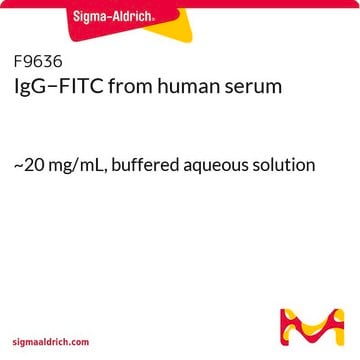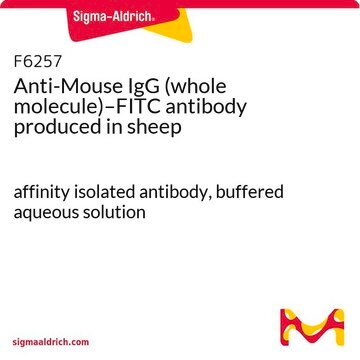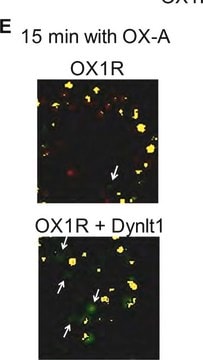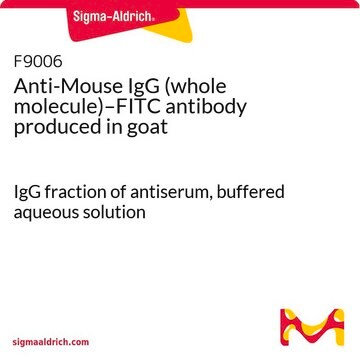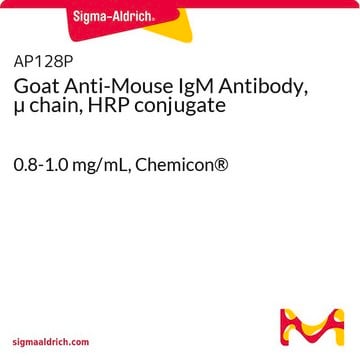F9259
Anti-Mouse IgM (μ-chain specific)–FITC antibody produced in goat
affinity isolated antibody, buffered aqueous solution
Synonym(s):
Mouse IgM antibody
Sign Into View Organizational & Contract Pricing
All Photos(1)
About This Item
Recommended Products
biological source
goat
conjugate
FITC conjugate
antibody form
affinity isolated antibody
antibody product type
secondary antibodies
clone
polyclonal
form
buffered aqueous solution
technique(s)
direct immunofluorescence: 1:128
storage temp.
2-8°C
target post-translational modification
unmodified
General description
IgM antibodies are present as pentamers in the serum and are produced in response to antigens
Anti-Mouse IgM (μ-chain specific)-FITC antibody is specific for mouse IgM with mu chain. The antibody preparation is specific for mouse IgM when tested against purified mouse IgA, IgG (all subclasses), and IgM. Goat anti-mouse IgM is then conjugated to Fluorescein Isothiocyanate (FITC), Isomer I.
Anti-Mouse IgM (μ-chain specific)-FITC antibody is specific for mouse IgM with mu chain. The antibody preparation is specific for mouse IgM when tested against purified mouse IgA, IgG (all subclasses), and IgM. Goat anti-mouse IgM is then conjugated to Fluorescein Isothiocyanate (FITC), Isomer I.
Specificity
Binds mouse IgM only; does not bind other mouse Igs.
Immunogen
Purified mouse IgM
Application
Anti-Mouse IgM (μ-chain specific)-FITC antibody may be used for immunofluorescent labeling of mouse spleen cells at a minimum working antibody dilution of 1:128. It was also used for immunohistochemistry of rat heart tissue sections at a working dilution of 1:50. A dilution of 1:100 was used to label human ovarian-adenocarcinoma cells for immunofluorescence.
Applications in which this antibody has been used successfully, and the associated peer-reviewed papers, are given below.
Immunofluorescence (1 paper)
Immunofluorescence (1 paper)
Physical form
Solution in 0.01 M phosphate buffered saline, pH 7.4, containing 1% bovine serum albumin and 15 mM sodium azide.
Disclaimer
Unless otherwise stated in our catalog or other company documentation accompanying the product(s), our products are intended for research use only and are not to be used for any other purpose, which includes but is not limited to, unauthorized commercial uses, in vitro diagnostic uses, ex vivo or in vivo therapeutic uses or any type of consumption or application to humans or animals.
Not finding the right product?
Try our Product Selector Tool.
Storage Class Code
10 - Combustible liquids
WGK
WGK 3
Flash Point(F)
Not applicable
Flash Point(C)
Not applicable
Certificates of Analysis (COA)
Search for Certificates of Analysis (COA) by entering the products Lot/Batch Number. Lot and Batch Numbers can be found on a product’s label following the words ‘Lot’ or ‘Batch’.
Already Own This Product?
Find documentation for the products that you have recently purchased in the Document Library.
Customers Also Viewed
F Carreiras et al.
International journal of cancer, 63(4), 530-536 (1995-11-15)
Accumulating evidence suggests that integrins, which participate in many complex cellular processes, are important for tumor progression and metastasis. In order to understand the role of these cell-surface receptors and of their ligands in the biological behavior of ovarian tumor
Bone marrow stromal cells improve cardiac performance in healed infarcted rat hearts
Olivares EL et al
American Journal of Physiology. Heart and Circulatory Physiology, 287, H646-H670 (2004)
Chenjie Zhou et al.
Hematology (Amsterdam, Netherlands), 22(2), 119-127 (2016-07-16)
Monoclonal anti-human blood group A (51A8) and B (63B6) antibody reagents were prepared using the serum-free technique. The aims of this research were to characterize the serum-free reagents and prove their reliabilities in routine use. Experiments including antigen-antibody agglutination testing
Joanna R Morris et al.
Human molecular genetics, 13(8), 807-817 (2004-02-21)
The N-terminus of the BRCA1 protein bears a RING finger domain that functions as an E3 ubiquitin ligase in vitro where it is able to catalyse the synthesis of monoubiquitin and polyubiquitin targeted proteins. This activity is greatly increased when
Akt-mediated anti-apoptotic effects of substance P in Anti-Fas-induced apoptosis of human tenocytes.
Ludvig J Backman et al.
Journal of cellular and molecular medicine, 17(6), 723-733 (2013-04-13)
Substance P (SP) and its receptor, the neurokinin-1 receptor (NK-1 R), are expressed by human tenocytes, and they are both up-regulated in cases of tendinosis, a condition associated with excessive apoptosis. It is known that SP can phosphorylate/activate the protein
Our team of scientists has experience in all areas of research including Life Science, Material Science, Chemical Synthesis, Chromatography, Analytical and many others.
Contact Technical Service








